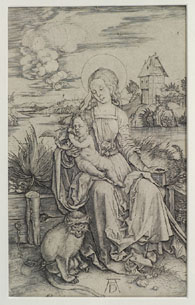The Madonna is sitting on a terrace and looking tenderly at Jesus sitting in her lap. In his hand the child is holding a bird, perhaps a goldfinch, and offering it a "teat" in the form of a piece of cloth that has been dipped in liquid. This is a reference to the Passion: on Calvary, a sponge soaked in vinegar was proffered to Jesus. The bird symbolises the soul's voluntary submission to the Saviour. Mary's right hand is resting on the Holy Book. The knot on the virgin's cloth belt symbolises the immaculate conception. Dürer drew Mary's halo as a simple circle, which is unique in his copper plate engravings.
A tethered monkey is shown at Mary's feet. The fact that the animal is depicted so realistically in the print suggests that Dürer may have had the opportunity to work with a live model. In the diary that he kept during his trip to Holland, Dürer writes that in December 1520 he had paid "four gold gulden for a monkey". During the Renaissance, the monkey was a general symbol of people's basest instincts, such as lust, gluttony, greed and selfishness. The shackled monkey represents the prison of secular pleasures, but it may also refer to the sinful Eve. Here, the monkey is the opposite of the pure mother of God.
The island abode in the background was built in the late part of the century as a place of refuge from the predicted deluge. The riverscape is based on the watercolour House by a Pond, now in the British Museum, which Dürer painted on the Pegnitz near St. John on the outskirts of Nürnberg. In the print, however, the house is a mirror image.
Dürer's monogram is placed at Mary's feet, slightly to the right of the picture' midline.

 Virgin Mary, Jesus child and monkey,
ca. 1498
Virgin Mary, Jesus child and monkey,
ca. 1498
 Virgin Mary, Jesus child and monkey,
ca. 1498
Virgin Mary, Jesus child and monkey,
ca. 1498